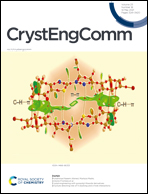Reticular synthesis of two anionic Zn(ii)-MOFs for organic dye adsorption/separation and lanthanide ion sensitization†
Abstract
Anionic metal–organic frameworks (MOFs) with a negatively charged framework have attracted extensive attention for their potential applications in organic dye adsorption and separation. However, the rational synthesis of anionic MOFs with tunable channel size is still difficult. In this work, two pillar-layered MOFs, namely [(CH3)2NH2]2[Zn4(BTC)2TCPB]·3DMF·H2O (JOU-44) and [(CH3)2NH2]2[Zn4(BPTC)2TCPB]·12DMF·6H2O (JOU-45), were solvothermally synthesized by using a reticular chemistry strategy (H3BTC = 1,3,5-benzenetricarboxylic acid; H3BPTC = [1,1′-biphenyl]-3,4′,5-tricarboxylic acid; H4TCPB = 1,2,4,5-tetrakis(4-carboxyphenyl)benzene). Structural analyses show that JOU-44 and JOU-45 show an isoreticular three-dimensional anionic framework based on [Zn2(COO−)5]− clusters. It should be noted that the pillar-layered framework of JOU-44 is expanded by adjusting the length of the ligands in the layer part, which is different from the pillar extension method reported in the literature. Due to its anionic and highly porous framework, JOU-44 was exploited for adsorption and chromatographic separation of organic dyes. In addition, JOU-44 was also developed as an antenna to selectively sensitize EuIII ions. This work provides a new clue for constructing pillar-layered MOFs with an extensible structure, as well as a new way to extend the applications of MOFs in separation and fluorescence.

- This article is part of the themed collection: Coordination Networks


 Please wait while we load your content...
Please wait while we load your content...